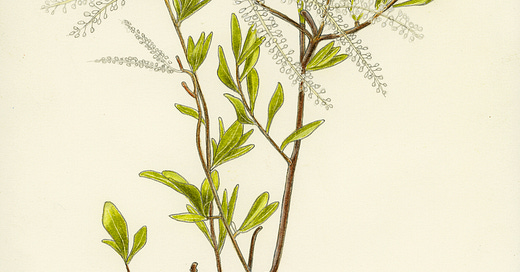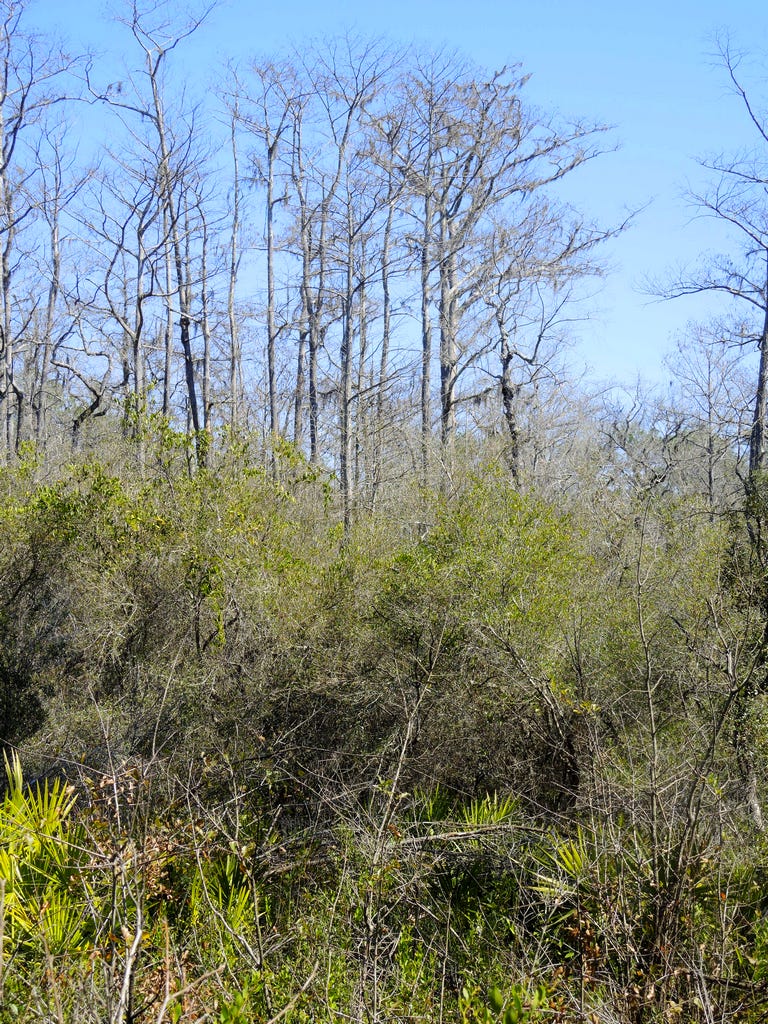The landscape of Florida is made of old beach sand perched on top of Swiss cheese, for the limestone on which we Floridians live is honeycombed with cavities and caves. In many places the roof of a cave has slumped or collapsed, dimpling Florida's surface with thousands of depressions and sinkholes that hold temporary or permanent water, their vegetation ranging from grassy ponds, holly swamps, to bay swamps, live-oak ringed ponds or my favorite, cypress ponds.
The finest cypress ponds have centers of permanent open water ringed by cypress trees but are hidden within a dense ring of titi, a large wetland shrub. It is possible to walk right by such a cypress pond and not know it is there, because it is more common for titi to form swamps with hectare after hectare of impenetrable wetland thicket, stem upon stem, laced with catbrier to snag your movement, and underlain by a thick layer of soggy, decaying leaves. Titi swamps do not invite exploration. But should you spot the bright, feathery tops of some cypress trees poking up behind the titi, it is time to find or force a way through the wall.

On the other side of the titi wall, you will have entered another world, another dimension, having left a sandy world of grassy open longleaf pine forest and entered a magical, wet world. You walk on springy blankets of decaying leaves, thick as a mattress, the water dark, ankle deep and deeper with every step. As you leave the thicket of titi stems, the wall gives way to reveal open water completely ringed by tall cypress and scattered bay trees, all with swollen bases, standing in still dark water.

It is all so surprising, so unexpected. You are in an enchanted room, a separate space, seemingly unconnected to where you just came from. Spanish moss drapes from branches, cypress trees with bear-shredded bark stand at the water's edge and the branches of long-dead cypress logs poke through the surface. Garlands of feathery roots spring from the bases of trees, buoyed by the acidic, infertile water from which they desperately seek nutrients. Knot-hole cavities in bay trees are home to nesting birds and raccoons.
At knee deep, you bump into a cypress log covered with a green freshwater sponge, you touch it, and your fingers smell bitter. Stand still and crayfish nibble gently at your toes. Look up and feel the enclosure of the place, the sense of disconnection from the world all around. Dragonfly pairs in tandem flit over the shallows, dipping and dropping eggs, the eggs like tiny white bombs sinking slowly to the bottom.

At waist deep in the stained water, your legs fade to deep red with depth, your feet have vanished, but you can still feel the bouncy, spongy bottom. Pale green bladder-wort mats offer their tiny traps to even tinier creatures and poke their yellow flowers above the water. The older traps are black with the digested remains of many victims, the traps now filled and useless.

In the spring, drowned grass stalks and fallen twigs are encased in thousands of greenish gelatinous masses of algae. Under the microscope, you can see the elongated, green cells arrayed in neat rows and columns, like armies of tiny green soldiers.

Rare little surprises await you, as when the margins of shallows become home to springtime blooms of the giant green ciliate, Stentor, in narrow drifts of millions of single-celled bodies rendered green by symbiotic algae. Poke a finger and they swirl around, their swift contractions visible even to the naked eye. Wait a minute and they expand their trumpet shaped bodies again, the giant cilia at their wide end creating a whirlpool.

In times of drought, the waters may recede to a small, deep spot in the middle, surrounded by carpets of dry bottom, the walking made easy, the crayfish long burrowed deep to outwait the drought, the algae on once-sunken logs bleached white.

But unlike its upland fire resistant cousin longleaf pine in its combustible habitat, cypress succumbs easily to fire, making it impossible for the two to share space. The pines, for their part, die when their feet are under water, assuring that the cypress trees have their exclusive places and the pines have theirs. Even so, cypress seeds only germinate on wet soil, not under water, so that seedlings appear when the seasons and the years expose pond margins, surrounding open ponds with a halo of cypress.
And every century or two, an extreme drought and an extreme fire coincide, and the trees die a fiery death, to be renewed within a few years by a new ring of young cypress and bay, and if the fire return is infrequent, to be sequestered again behind a rebuilt wall of titi.







Again Walter you describe the world in elegant descriptive biological terms, an array here of what is the composition of a Florida cypress swamp. I have been in mourning recently since Hurricane Debby, a category 1, swept through my old home and land in Jefferson County and brought down three huge trees, a red oak that had framed my front yard for over 35 years, a cedar my son once climbed in when he was young, and a tulip popular that he had watched grow to its great height. I was in shock when I saw the destruction.
I’ve never made out to a cypress swamp. It’s on the top of my List of things to do. Thank you for transporting me there Walter